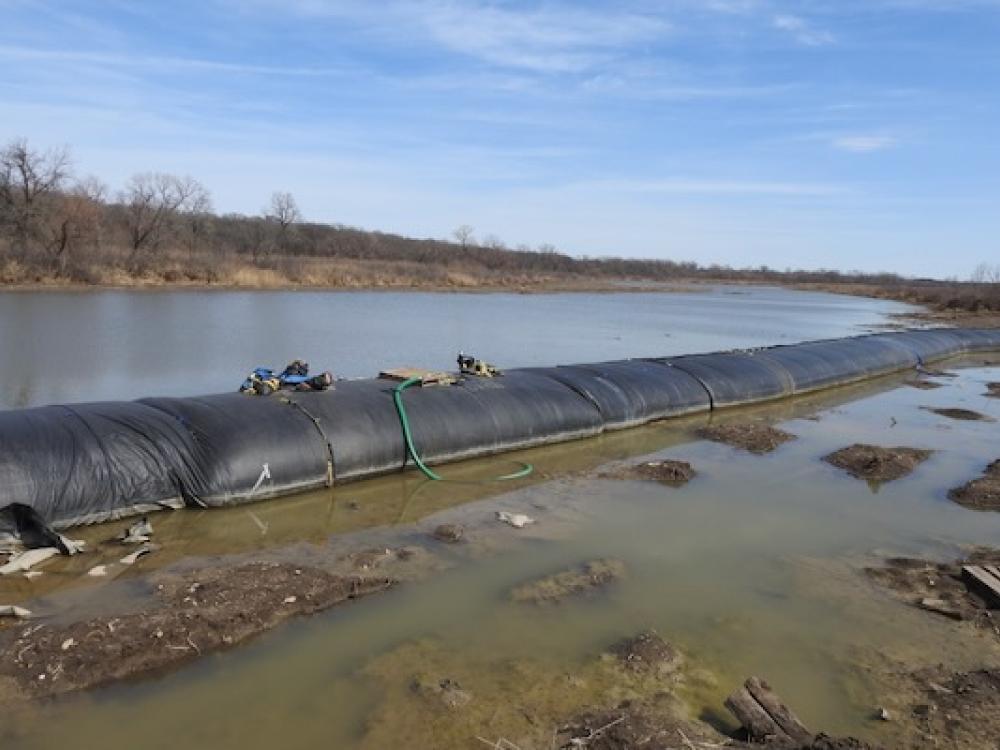
The AquaDam stretches around the boardwalk construction site at the Fort Worth Nature Center. Photo by Michael Smith.
March 22, 2023
For decades, the boardwalk at the Fort Worth Nature Center and Refugee has lured thousands of nature lovers to the water's edge.
Now the over-water feature is getting an upgrade.
The Marty Leonard Lotus Marsh Boardwalk, recently renamed for philanthropist and longtime FWNCR supporter Marty Leonard, is being restored to its former glory — and improved.
According to the Friends of the Fort Worth Nature Center and Refuge, the construction project underway is the largest funded capital project to occur at the Nature Center in 50 years.
MARSH MADNESS
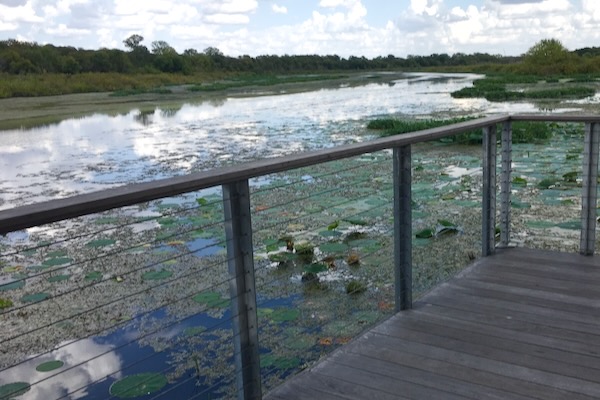 The view from the Marty Leonard Lotus Marsh Boardwalk at the Fort Worth Nature Center in 2020 looking northeast. Photo by Julie Thibodeaux.
The view from the Marty Leonard Lotus Marsh Boardwalk at the Fort Worth Nature Center in 2020 looking northeast. Photo by Julie Thibodeaux.
The Fort Worth Nature Center is bordered by two lakes — Eagle Mountain to the north and Lake Worth to the south. The West Fork of the Trinity River flows between them, feeding a beautiful marsh within the Nature Center.
The boardwalk is a quiet place to watch great blue herons hunt among the reeds, listen to choruses of treefrogs at dusk or peer into the wetland habitat, as clouds roll by in the water’s reflections.
Since the 1970s, a boardwalk allowed visitors to walk across the flooded landscape. But weather and water eroded the wood.
In 2017, the main boardwalk platform, which juts out perpendicular from the shore, was rebuilt, but not the side section that extended laterally. That part of the boardwalk is now under construction, with a projected completion date in June.
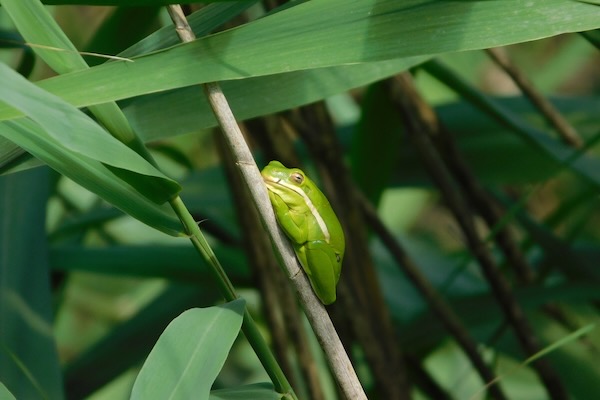 A green treefrog spotted just off the Marty Leonard Lotus Marsh Boardwalk at the Fort Worth Nature Center. Photo by Michael Smith.
A green treefrog spotted just off the Marty Leonard Lotus Marsh Boardwalk at the Fort Worth Nature Center. Photo by Michael Smith.
NEW FEATURES
Unlike the old boardwalk, there will be no steps down to this extension of the boardwalk. It will be gently ramped so that anyone using a wheelchair or walker can make full use of it.
“At the shoreline it will be one foot above water level when Lake Worth is full,” said Rob Denkhaus, Nature Center Manager.
That will allow for dip-netting and other supervised educational activities led by staff. Right there, practically at eye level, there might be dragonfly nymphs, tadpoles or little groups of mosquitofish darting among the reeds.
Other amenities planned include an improved parking area and a new restroom, similar to the one located at the Greer Island trailhead. The adjacent trail that follows the shore southward, weaving through trees and marsh inlets, will be banked and graveled.
“The whole project cost $3 million,” said Denkhaus. “Half that amount came from a grant from Texas Parks and Wildlife Department.”
Matching funds came from the City of Fort Worth, which donated 1.2 million, and the Friends of Fort Worth Nature Center & Refuge, which gave $300,000.
BUILDING IN WATER
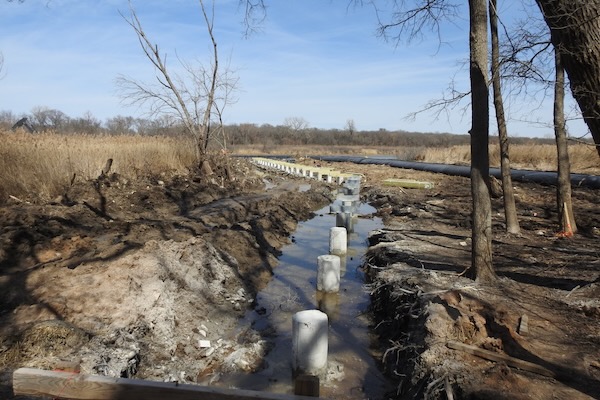 The new boardwalk addition loops around to reach the shore. Photo by Michael Smith.
The new boardwalk addition loops around to reach the shore. Photo by Michael Smith.
A primary consideration in constructing the boardwalk was to do it without creating lasting ecological damage. There was no way to do it without creating some limited, temporary havoc. The key was for the disturbance to be the kind that the marsh can easily recover from.
The first thing was to exclude water from the construction area.
The Fain Group, the Fort Worth-based contractor for the project, placed a flexible, temporary dam around the construction area. This AquaDam was rolled out into the marsh in segments. Each segment, when inflated with water, locks to the next one.
More segments were added until the area around the boardwalk was bordered by a half-circle of dam, looking like a gigantic eel half-sunk in the water. The weight of the water inside that big black tube holds it firmly against the bottom of the marsh. As a result, little water leaks into the construction site.
“We have 1,100 feet of AquaDam out there,” said Steven Aguirre, superintendent with Fain.
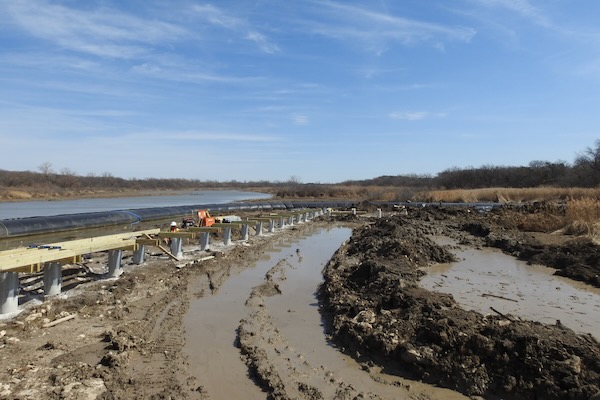
Construction of the new boardwalk underway in February. Photo by Michael Smith.
Needless to say, getting it into position took some doing, since trees and shrubs grow right down to the shore, and then there are reeds and shrubs growing in shallow water.
“Then we built this berm to prevent the water coming into the work area” (inside the dam),” Aguirre explained.
According to Denkhaus, “The holes for the concrete pillars that support the boardwalk are bored down about 17 feet,” deep enough to reach a layer of rock.
After the concrete is poured, workers can construct the supports and then the walking surface.

A large excavator making its way to the construction site. Photo by Michael Smith.
The Fain Group and FWNCR staff considered every strategy to protect this section of the marsh. For example, there had to be a path for equipment to be driven down to the construction site, and rock had to be added to the mud so that the equipment would not get stuck.
What sort of rock would you use? If rock was brought from somewhere else, its mineral content could change the water and soil chemistry, and so they used limestone like that found on the refuge property.
POST-CONSTRUCTION RECOVERY
When the construction is finished, the Fain Group will excavate the berm and re-grade the bottom of the marsh similar to its original slope.
“Then the water does the rest of the work for us,” Aguirre said, meaning that the movement of water and the plants and animals that come with it will restore the area.
When the equipment is gone and the floor of the marsh is restored as much as possible, plants will return.
Marshes are relatively shallow and they support emergent plants (those rooted in underwater soil but growing above the water level). The return of plants could be from buried seed or transport by wind and water.
“The seed bank is still there and will come back quickly,” said Denkhaus.
 Turtles bask on a dilapidated section of boardwalk in October 2020. Photo by Michael Smith.
Turtles bask on a dilapidated section of boardwalk in October 2020. Photo by Michael Smith.
The marsh has sometimes been referred to as “the lotus marsh,” because periodically the water is covered with the large round leaves and beautiful flowers of the lotus plant.
“Lotus will come back as nature brings it,” said Denkhaus. “Upstream releases of water periodically scour the lotus out — which is why we have it now, downstream at Greer Island.”
It has been a few years since the first phase of construction in 2017, but lotus is taking hold at the marsh again, and should quickly return around the boardwalk.
DECK WITH A VIEW
 The Fort Worth Nature Center and Refuge held a grand opening for its new bison viewing deck on March 5. Photo by Michael Smith.
The Fort Worth Nature Center and Refuge held a grand opening for its new bison viewing deck on March 5. Photo by Michael Smith.
Another new viewing spot at the Fort Worth Nature Center opened on March 5. The Bison Viewing Deck features a ramp with two viewing platforms, raising visitors up in the canopy of the woods that border the bison enclosures. Look for the GreenSourceDFW.org story about the bison deck coming soon.
RELATED ARTICLES
New land acquired by Fort Worth Nature Center will serve as buffer
Alligator sightings stir up neighbors near Lake Worth
Fort Worth Nature Center offers window into region’s wild past
Stay up to date on everything green in North Texas, including the latest news and events! Sign up for the weekly Green Source DFW Newsletter! Follow us on Facebook and Twitter. Also check out our new podcast The Texas Green Report, available on your favorite podcast app.









